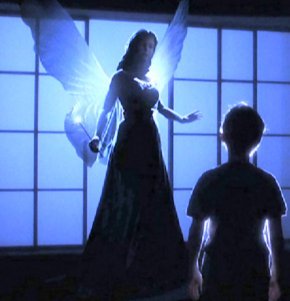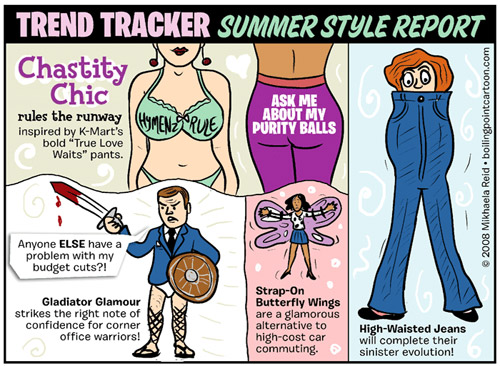Pfft — diamonds.
There was a silly little girl in line behind me at Victoria’s Secret a while back who said to a girlfriend, "You know, it’s not even about him. I just want that ring on my finger." Ah, the basis for a long-lasting marriage.
Aesthetically, diamonds are dull. Clear, sparkly, round, blah, blah, blah. Historically, they were rare. But even before I read the 1982 Atlantic Monthly article, I suspected that if nearly everyone had a diamond in some form or another (not to mention the vaults full of them all over the world), they were not rare, not valuable, not special.
In 1870, however, huge diamond mines were discovered near the Orange River, in South Africa, where diamonds were soon being scooped out by the ton. Suddenly, the market was deluged with diamonds. The British financiers who had organized the South African mines quickly realized that their investment was endangered; diamonds had little intrinsic value and their price depended almost entirely on their scarcity. The financiers feared that when new mines were developed in South Africa, diamonds would become at best only semiprecious gems.
Oh no — you have a supply of junk but want the cash to keep rolling in? Well, just form a company and get a slogan.
The diamond invention is far more than a monopoly for fixing diamond prices; it is a mechanism for converting tiny crystals of carbon into universally recognized tokens of wealth, power, and romance. To achieve this goal, De Beers had to control demand as well as supply. Both women and men had to be made to perceive diamonds not as marketable precious stones but as an inseparable part of courtship and married life. To stabilize the market, De Beers had to endow these stones with a sentiment that would inhibit the public from ever reselling them. The illusion had to be created that diamonds were forever — "forever" in the sense that they should never be resold.
But, how, oh how to convince gullible people to buy something they don’t need. Why, you need advertising professionals!
In its 1947 strategy plan, the advertising agency strongly emphasized a psychological approach. "We are dealing with a problem in mass psychology. We seek to … strengthen the tradition of the diamond engagement ring — to make it a psychological necessity capable of competing successfully at the retail level with utility goods and services…"
Now, aim below the belt. Aw hell, just aim to unlock the chastity belt.
N. W. Ayer outlined a subtle program that included arranging for lecturers to visit high schools across the country. "All of these lectures revolve around the diamond engagement ring and are reaching thousands of girls in their assemblies, classes and informal meetings in our leading educational institutions," the agency explained in a memorandum to De Beers.
Too bad that thing on your finger is completely worthless.
The appraisers at Empire Diamonds examine thousands of diamonds a month but rarely turn up a diamond of extraordinary quality. Almost all the diamonds they find are slightly flawed, off-color, commercial-grade diamonds. The chief appraiser says, "When most of these diamonds were purchased, American women were concerned with the size of the diamond, not its intrinsic quality." He points out that the setting frequently conceals flaws and adds, "The sort of flawless, investment-grade diamond one reads about is almost never found in jewelry."
But who cares — the masses have been convinced. Now, about those teeny tiny rocks dug up in the Soviet Union that are hitting the market: lather, rinse, repeat.
The diamond market had to be further restructured in the mid-1960s to accomodate a surfeit of minute diamonds, which De Beers undertook to market for the Soviets. They had discovered diamond mines in Siberia, after intensive exploration, in the late 1950s: De Beers and its allies no longer controlled the diamond supply, and realized that open competition with the Soviets would inevitably lead, as Harry Oppenheimer gingerly put it, to "price fluctuations,"which would weaken the carefully cultivated confidence of the public in the value of diamonds.
… De Beers devised the "eternity ring," made up of as many as twenty-five tiny Soviet diamonds, which could be sold to an entirely new market of older married women. The advertising campaign was based on the theme of recaptured love. Again, sentiments were born out of necessity: older American women received a ring of miniature diamonds because of the needs of a South African corporation to accommodate the Soviet Union.
Imagine — all this time you’ve been concerned about heroin and gas supporting terrorism. You never even thought that the "symbol" on your finger once funded those dirty commies!
Some hundred-million women wear diamonds, while millions of others keep them in safe-deposit boxes or strongboxes as family heirlooms. It is conservatively estimated that the public holds more than 500 million carats of gem diamonds, which is more than fifty times the number of gem diamonds produced by the diamond cartel in any given year.
So, let’s review:
-
Diamonds are not rare. Keep in mind, this article was written 25 years ago – there are probably billions of diamonds out there by now.
-
Diamonds are not forever — after all, more than half of all marriages end in divorce.
-
Diamonds do not equal love. They equal retail sales = stock points = corporate salaries.
Diamonds are not special — with enough years of savvy marketing, a few suits can convince us to buy anything. So the next time a girl sticks out her hand and squeals, laugh at her. The next time a woman shows off her "right-hand-independent-woman-band," roll your eyes. The next time you’re in a mall and you’re drawn to the window of [correction – average mall jewelry store], oggling the (literally) piece of dirt set in something gold-plated, displayed in a cheap velvet box, priced at $99, that millions of other suckers will buy to appease some chick, just walk away. Listen to Ken Mondschein over at Nerve:
In short, diamonds not only aren’t a girl’s best friend, they’re also bad for human rights and the environment. Worse, they’re a symbol of the same conspicuous-consumption consumer culture that reduces human relationships to a bank balance. With a thousand and one creative ways to show your love for each other — claddagh rings, pornographic medieval badges — a diamond-free engagement band shows love for the rest of the world.
Jennifer Leblanc
Dear Reader,
In The Fray is a nonprofit staffed by volunteers. If you liked this piece, could you
please donate $10? If you want to help, you can also:














